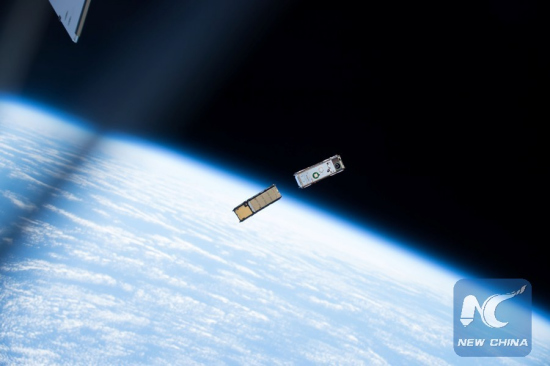
The bread loaf-sized IceCube was deployed from the International Space Station in May. One month later, it began science operations gathering global data about atmospheric ice clouds in the submillimeter wavelengths. (Credit: NASA)
An experimental small satellite captured the first global picture of small frozen particles inside ice clouds, the United States space agency NASA said on Tuesday.
IceCube, a satellite deployed from the International Space Station in May 2017, is testing instruments for their ability to make space-based measurements of the small, frozen crystals that create enormous rain clouds.
"Heavy downpours originate from ice clouds," said Dong L. Wu, IceCube principal investigator at NASA's Goddard Space Flight Center.
Ice clouds start as tiny particles high in the atmosphere. Absorbing moisture, the ice crystals grow and become heavier, causing them to fall to lower altitudes. Eventually, the particles get so heavy, they fall and melt to form rain drops. The ice crystals may also just stay in the air.
Like other clouds, ice clouds affect Earth's energy budget by either reflecting or absorbing the Sun's energy and by affecting the emission of heat from Earth into space. Thus, ice clouds are key variables in weather and climate models.
Measuring atmospheric ice on a global scale remains highly uncertain because satellites have been unable to detect the amount of small ice particles inside the clouds, as these particles are too opaque for infrared and visible sensors to penetrate.
To overcome that limitation, IceCube was outfitted with a submillimeter radiometer that bridges the missing sensitivity between infrared and microwave wavelengths.
Despite weighing only 4.5 kilograms and being about the size of a loaf of bread, IceCube is a bona fide spacecraft, complete with three-axis attitude control, deployable solar arrays and a deployable ultra high frequency communications antenna, according to NASA.
The satellite spins around its axis, like a plate spinning on a pole. It points at Earth to take a measurement then looks at the cold space to calibrate.
Originally a 30-day technology-demonstration mission, IceCube is still fully operational in low-Earth orbit almost a year later, measuring ice clouds and providing data that's "good enough to do some real science," Wu said.


















































